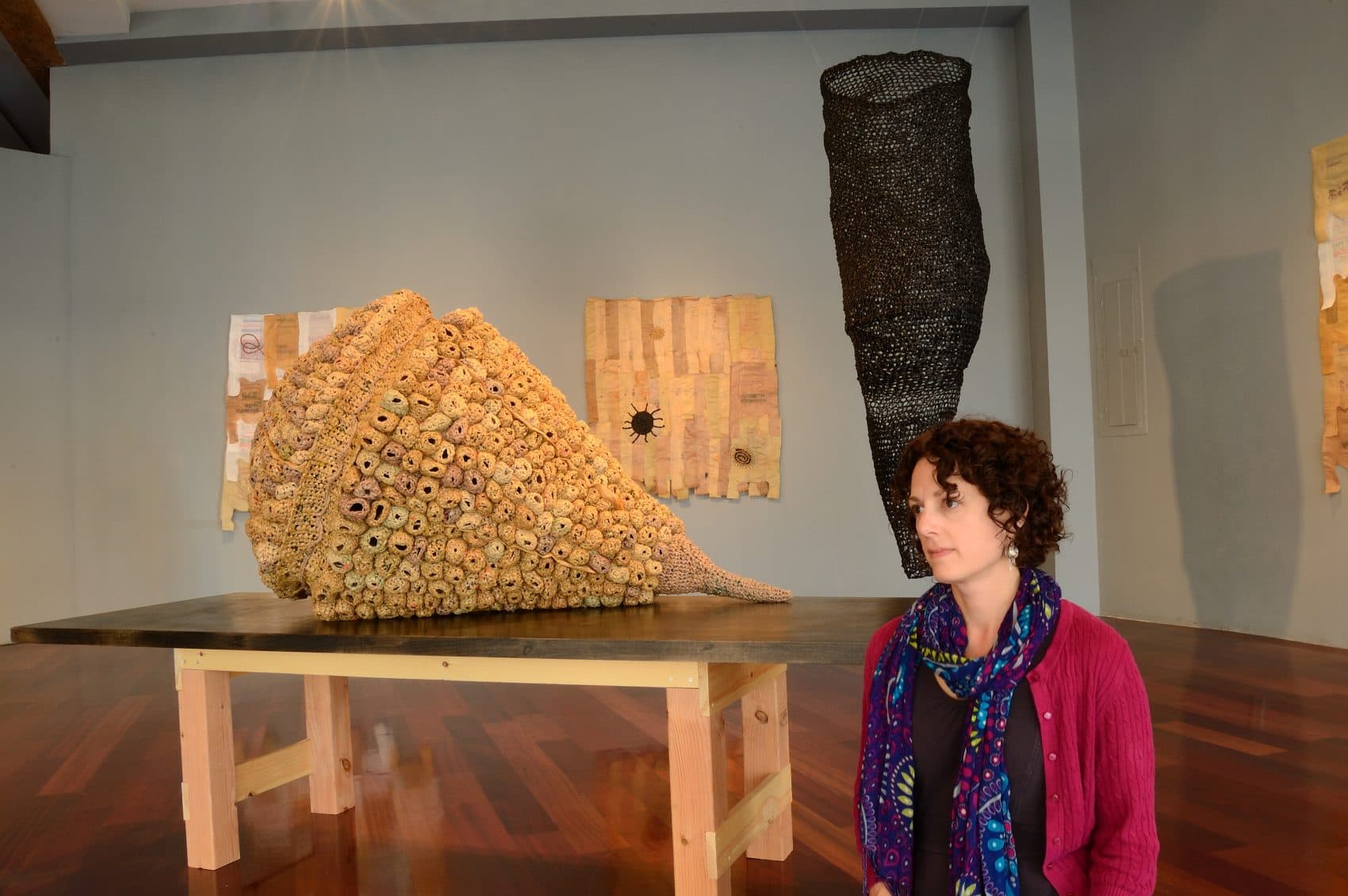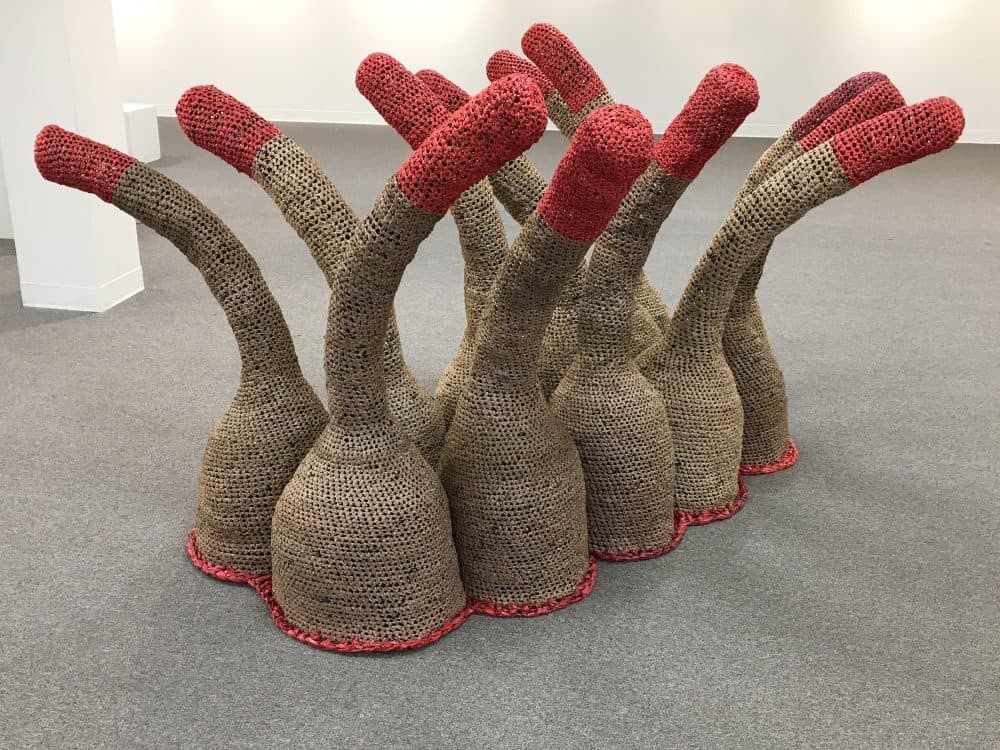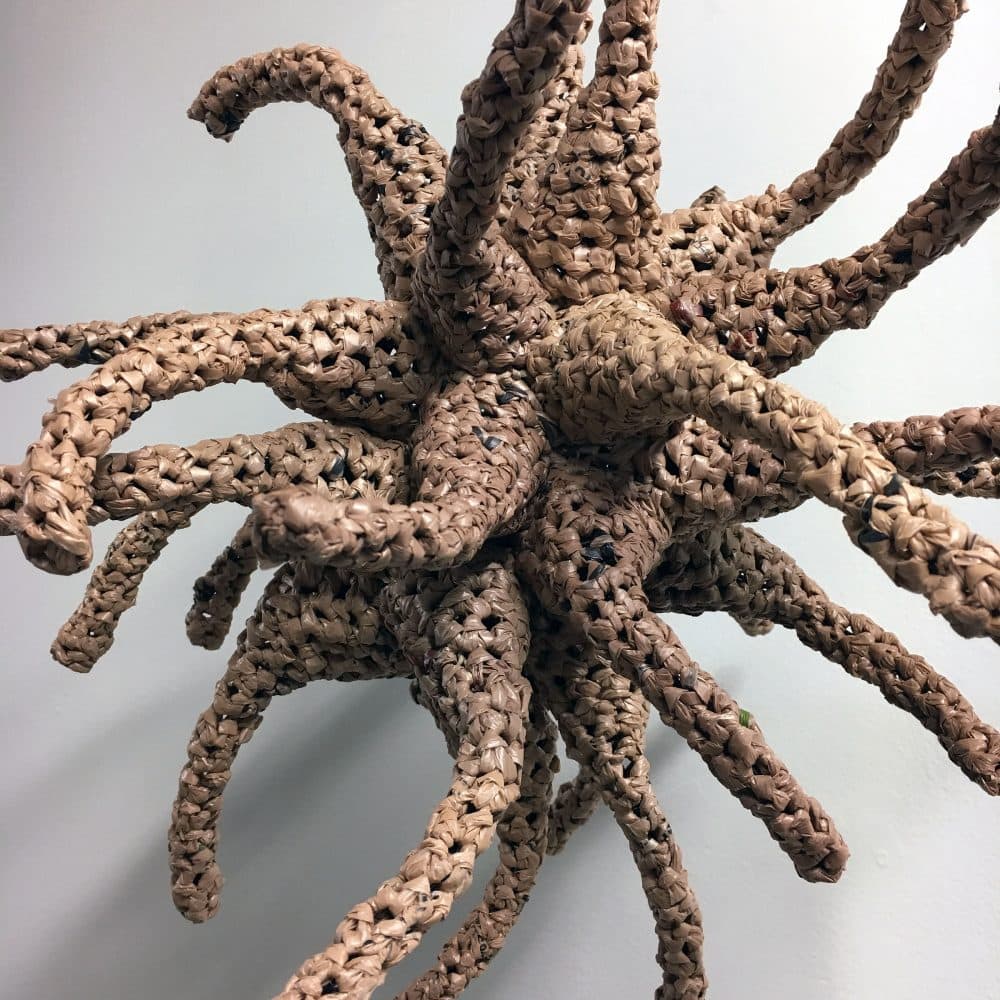Advertisement
Crocheting Plastic Into Sculpture, A Cambridge Artist Calls For Environmental Action

Bobbing aimlessly in the ocean between Hawaii and California is a thin soup of trash and plastic measuring twice the size of Texas.
Referred to most often as the Great Pacific Garbage Patch, it is a collection of 1.8 trillion pieces of rubbish, ranging from plastic flakes to shoes to fishing nets and even computer monitors. Some of the garbage is by now only microplastic, ingested by unfortunate sea animals in the wrong place at the wrong time. (Planet Earth, year 2018.) Other refuse is heavy enough to sink to the sea floor, while larger, buoyant items float. In all, the debris is said to weigh an estimated 80,000 metric tons. Most disturbing, the garbage patch, also known as the Pacific Trash Vortex, is not an aberration. It is the largest of five plastic accumulation zones floating around the world’s oceans. (Depressing.)
When artist Michelle Lougee learned of this distressing fact about a decade ago, she, like most of us, was horrified. In her own idiosyncratic way, the Cambridge artist decided to do something about it. She started crocheting sculptures made of the ever present, always ubiquitous plastic bag.
“I learned about the plastic in the oceans and the plastic gyre and the other gyres where trash is collecting and causing a lot of problems for ocean creatures, and I learned to crochet approximately at the same time,” she recalls. “The two ideas seemed to marry really well together.”
She remembers that someone around that time sent her a link asking her whether she knew that a plastic bag could be used in crochet. She hadn’t known, but it was an intriguing idea.
“So I learned on YouTube,” she says. “And then I was off!”
She started by crocheting marine animals, the very same creatures threatened by mounting piles of plastic — octopuses, jellyfish and coral. She made them out of those brown plastic bags found at stores like Shaw’s, Home Depot and Hannaford, as well as the light green plastic bags used to collect produce at the grocery store. Of course, she never had a problem finding her “art supplies.” In fact, on many city streets, such bags can be plucked directly from tree limbs.
The forms she created were elegiac, a memorial, a call to action. Although her work can appear, at first glance, whimsical and lighthearted, the deeper point about our disdain for our planet and other forms of plant and animal life, our carelessness toward the environment, our unbridled consumerism and the fact that time is quickly running out also comes across loud and clear.
Advertisement
Since she began working with plastic bags, Lougee estimates that she has used thousands of them. At home in daily life, she avoids them, favoring reusable cloth bags for shopping, but her friends, students at Lesley where she teaches and people who know of her work bring her a never-ending supply, despite the fact that many municipalities, including Boston, Brookline and Cambridge, have passed laws either reducing or eliminating their use.

Out of the loathsome little sacs, Lougee creates forms that feel pleasurably sensual, fleshy and corporeal, like an animal or some organic material that you might find on the forest or sea floor. You don’t always know exactly what the shape is, but it always feels vaguely recognizable — perhaps a mollusk, a bee hive, a wasp’s nest or a seed pod. Her work is suggestively biomorphic and organic, belying the synthetic material she uses, but her forms have grown increasingly abstract over time.
Starting on June 13, her work is featured in a show entitled “Timber!” at Boston Sculptors Gallery in the South End. The show, running through July 15 congruently with a show by Liz Shepherd, is a collection of 10 to 15 sculptures, some quite large, that contemplate aspects of regeneration. As Lougee typically does, shapes will suggest seed pods, larvae, trees and other natural forms, but this time speaking to the idea of rebirth, metamorphosis and growth.
“The title of my show ’Timber!’ goes back to my apocalyptic view,” says Lougee. “I am creating forms inspired by seeds but producing them from plastic, which continually threatens our environment. They are meant to be a warning, but a seed, in essence, is hopeful.”
For those craving more of Lougee, her work will also be featured in a show entitled “The Life of Forms: Susan Heideman and Michelle Lougee” at the Chandler Gallery at Maud Morgan Arts. That show runs Aug. 13 through Sept. 7.

It was in grad school at BU that Lougee began moving away from the traditional medium of clay cast into plaster, and toward other unconventional materials in her work that was at that time focused on the human figure.
“I made a life-size figure out of found wood — branches and that sort of thing, a pregnant figure,” she explains. “That started me toward this earth mother sort of direction, thinking about protecting the environment and incorporating that into my work.”
From that point on, Lougee moved into other shapes outside the human figure, biomorphic forms that sometimes look human, but that can also resemble bacteria, insects, sea or plant life.
“When I was making more recognizable ocean creatures I felt like it’s almost too easy,” she says. “I like it to be in an area where it can go in several other directions. It might remind one person of one thing and another person of another thing. It’s not as prescribed as, ‘this is an octopus.’”
She can spend months working on one piece — the sculpture entitled “Larva,” which is shown as part of her current show, is a large tentacled form with 12 red-tipped appendages — took nearly a year to complete. There is a certain amount of tedium in the creation, as each plastic bag needs to be “processed” before she can use it. That involves cutting off the handle and seams of each bag and cutting it into one-inch segments that then get looped together.

“It’s simple but it’s time consuming,” says Lougee. “It’s like spinning. You have to collect and process the material to get it to a point where you can start working.”
When she works, she is not so much thinking about the larger environmental issues that originally inspired the work as about the form itself, and “whether I have the right color,” she says.
But the larger importance of her work is always there and in a small way, she hopes her work is contributing to change, or at least to awareness.
“I’m trying to address excess or pollution in my work, but also by making this work out of plastic bags, I’m removing some of these materials from the waste stream. It’s an action as well as an art project."
Michelle Lougee’s show “Timber!” will be at Boston Sculptors Gallery from June 13 until July 15 with an opening reception on June 16. “The Life of Forms: Susan Heideman and Michelle Lougee” is at Chandler Gallery at Maud Morgan Arts Center from Aug. 13 until Sept. 7 with an opening reception on Aug. 16.
